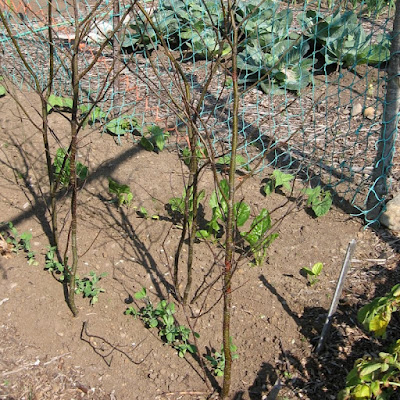I went on down to the dock to bail out my rowboat, Roseneath. She had taken a lot of water in the latest rainstorm and it was past time for me to dry her out. As I approached the dock I could hear the lamb more clearly. It wasn't at the fish house after all. At first I thought it might be caught somewhere near the dock, but soon I realized that it was way over on the point. Now I could see it wandering disconsolately back and forth, answering its mother. The point is a long way around the cove from the fish house and I wondered how they would find each other.
But I remembered what LeRoy told me: don't try to help. They will find each other in the end.So I climbed down into the rowboat and got on with bailing.
I watched a speedboat coming across the channel from the direction of Gunning Cove. It went on around the outside of the point, in the direction of the lighthouse. The lamb and the ewe continued calling to each other across the cove. By now the ewe and a couple of her ewe friends had walked down the path to the fish house. She was standing on the shore, looking out over the water in the direction of the point.
Some time later I began to hear the lamb making a different sound. Written on the page, it could look like: glub, glub, baaa -- glub, glub, baaa. The baaas were growing weaker, too. In its determination to find its mother, the lamb had decided to take the shortest route. It had plunged into the cove waters and was trying to swim across. It would never make it, though. The waters were placid but the distance from shore to shore is about two hundred yards. It would tire and drown.
Then I heard the speedboat coming slowly into the cove. Evidently the boaters -- an older man, a younger man, and a couple of kids and dogs -- had noticed the lamb on their way out, then seen it in the water as they were coming back. They had decided to help. They cut the motor and rowed, I guess, to the lamb. I had climbed up onto our dock, but I couldn't really see what was happening just then. They reached over the side and held the lamb's head, then slowly motored across the cove, toward the fish house. I heard one of them say, "I can't believe we are sheep savers!" Which they were.
When they approached the fish house and the rocky shore there, they let the lamb go. But instead of heading toward the shore, it swam in a circle around the boat and tried to stay with it. Then the boaters held its head again and using their oars they rowed among the underwater rocks, closer to the shore. They let the lamb go again and this time it swam to shore and slowly clambered up rockweed-covered rocks.
All this time the mother had been watching, standing next to the fish house. Now she began calling out again. I thought the lamb would be exhausted but since it had a free ride, it wasn't. It trotted through the woods and met up with its mother and her two ewe friends. There was much wiggling and greeting and then the four of them pranced merrily up the path together. The sheep savers went on their way, having done a very good deed which I was lucky to observe.
I had bailed out Roseneath by now, so I rowed out to check the gillnet. When I came back the little group had moved into the lower orchard. The lamb looked especially clean after its bath in the cove, and it was keeping close to its mother.
When I was rowing in the cove I saw the larger part of the flock out on the point. The smaller group -- the group at our house --must have gotten separated after the great ingathering last Thursday. The flock on the point was eating kelp and lying about peacefully. One lamb was off by itself though, standing on the ridge and crying for its mother. I'm pretty sure they will find each other in the end.

This story is illustrated with a map. But the map does not show everything there is to see around the cove. It only shows the places and characters that are mentioned in the story. As always, you can click on the image if you want to enlarge it.
































































.gif)
